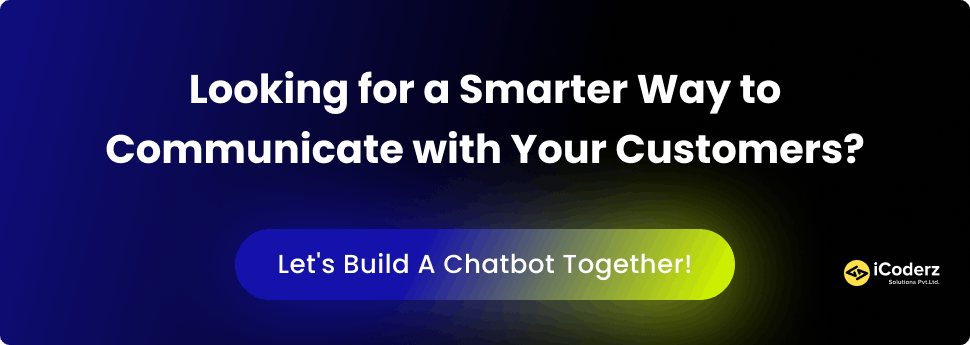Table of Contents
- What is Chatbot?
- Benefits of Using Chatbots for User Experience Improvement
- Latest Chatbot Trends and Technologies in 2023
- How to Design a Good Chatbot Experience
- Tips for Implementing the Latest Chatbot Trends in 2024
- Examples of Innovative Use Cases in the Industry
- Understanding the Major Challenges of Chatbots in Today’s Digital Landscape
- Conclusion
In a world where technology has taken the center stage, chatbots have become an indispensable tool for businesses that want to provide excellent customer service. In recent years, they have evolved from simple question-answering machines to intelligent conversationalists capable of understanding natural language and providing personalized recommendations. With 2023 fast approaching, it’s time to explore the Latest Trends in Chatbot Development Services that will take your user experience to a whole new level. From voice-enabled bots to emotion-sensing algorithms, this blog post covers it all! So grab a cup of coffee and join us as we dive into the exciting world of chatbots.
What is Chatbot?
As the name suggests, chatbots are computer programs that can simulate human conversation. They can also be used for marketing, sales, and even human resources.
Chatbots have been around for a while but they are constantly evolving. The latest chatbot trends include artificial intelligence (AI), natural language processing (NLP), and virtual assistants. These technologies are making chatbots more sophisticated and effective than ever before.
AI-powered chatbots can understand complex questions and provide accurate answers. NLP allows chatbots to understand the user’s intent and respond accordingly. Virtual assistants can handle tasks such as scheduling appointments and sending reminders.
The use of chatbots is growing rapidly and they are quickly becoming an essential part of any business’s online presence.
Benefits of Using Chatbots for User Experience Improvement
Chatbots can provide many benefits for improving user experience, some of which are:
- 24/7 Availability: Chatbots can be available 24/7, providing users with immediate assistance at any time. This can enhance the user experience by providing support outside of regular business hours and improving response times.
- Personalization: Chatbots can be programmed to personalize interactions with users, based on their previous interactions, preferences, and behavior. This can improve user experience by providing a tailored experience that feels more human-like.
- Speed and Efficiency: Chatbots can provide faster response times and handle more queries simultaneously than human support staff. This can improve user experience by reducing wait times and increasing efficiency.
- Cost Savings: Chatbots can provide cost savings by reducing the need for human support staff, especially for routine queries. This can result in lower operational costs, allowing businesses to invest more in other areas that can further improve user experience.
- Consistency: Chatbots can provide consistent responses, ensuring that all users receive the same level of service. This can improve user experience by reducing confusion and frustration due to inconsistent support.
- Data Collection: Chatbots can collect user data, such as their preferences and behavior, which can be used to improve user experience in the future. This can help businesses gain insights into user behavior and tailor their services to meet their needs better.
- Scalability: Chatbots can scale to handle a large volume of queries simultaneously, making them an ideal solution for businesses experiencing rapid growth. This can improve user experience by ensuring that support is available even during times of high demand.
Latest Chatbot Trends and Technologies in 2023
In 2023, Chatbot Trends and Technology will continue to evolve and become more sophisticated. Here are a few Most Popular Chatbot Trends and technologies that you can expect to see in the coming year:
- Natural Language Processing (NLP): NLP will continue to be a crucial component of chatbots, enabling them to understand and interpret user language. NLP will become more advanced, allowing chatbots to recognize and respond to more complex queries and commands.
- Voice-Based Chatbots: Voice-based chatbots will become increasingly popular in 2023, with more businesses integrating voice assistants like Amazon Alexa and Google Home into their chatbot strategies. Voice-based chatbots will offer a more natural and convenient way for users to interact with businesses.
- Integration with Social Media: Chatbots will continue to be integrated with social media platforms such as Facebook Messenger, WhatsApp, and Instagram, allowing businesses to reach customers on their preferred social media channels. Social media chatbots will offer a personalized and convenient way for customers to engage with businesses.
- Chatbots for E-Commerce: Chatbots will continue to be a valuable tool for e-commerce businesses, helping customers find products, place orders, and track shipments. Chatbots will become more sophisticated, offering a more personalized and engaging shopping experience for customers.
- Personalization and Context-Awareness: Chatbots will become more personalized and context-aware, offering tailored responses based on user behavior, preferences, and history. This will help chatbots provide more relevant and helpful information to users.
- Integration with Machine Learning and AI: Chatbots will be integrated with machine learning and AI to provide more intelligent and predictive responses to user queries. Machine learning algorithms will enable chatbots to learn from user interactions, improving their responses over time.
- AI-powered chatbots: AI-powered chatbots are becoming increasingly popular as they can provide more personalized and human-like conversations. In 2023, we can expect to see more AI-powered chatbots that can understand human emotions and intentions.
- Conversational commerce: Conversational commerce is a trend that has been growing in popularity in recent years. It refers to the use of conversational interfaces (such as chatbots) to buy and sell products or services. In 2023, we can expect this trend to continue as businesses look for ways to provide a better customer experience.
- Increased use of voice assistants: Voice assistants such as Amazon Alexa, Google Assistant, and Apple Siri are becoming increasingly popular.

How to Design a Good Chatbot Experience
Designing a good chatbot experience requires careful planning and execution. Here are some steps you can follow to create a successful chatbot experience:
- Define the Purpose and Scope of Your Chatbot: Before you start designing your chatbot, you need to determine its purpose and scope. Ask yourself what the chatbot should do and what problems it should solve. Determine the types of conversations it will handle and what actions it will take.
- Choose the Right Platform: There are many chatbot platforms available, and you need to choose the one that suits your needs. Consider the features you need, the complexity of the chatbot, and the programming languages you are familiar with.
- Develop a Personality and Voice for Your Chatbot: Chatbots can be designed to have a unique personality and voice. Consider the audience you are targeting and the type of tone that will resonate with them. The personality and voice of your chatbot should be consistent with your brand.
- Create a Simple and Clear User Interface: The user interface should be easy to understand and navigate. The chatbot should be able to provide clear instructions and prompt users when needed. The interface should also be visually appealing, with the right colors and fonts.
- Implement Natural Language Processing: Natural Language Processing (NLP) is an essential component of chatbots. It allows the chatbot to understand and interpret the user’s language. It is essential to ensure that the chatbot can handle different languages and dialects.
- Use Machine Learning: Machine Learning is another important component of chatbots. It enables the chatbot to learn from user interactions and improve its responses over time. The chatbot should be able to adapt to new situations and provide more accurate responses.
- Test and Iterate: Once you have developed the chatbot, it is essential to test it thoroughly. Test the chatbot with real users to identify any issues and make improvements. Use the feedback you receive to iterate and improve the chatbot.
Tips for Implementing the Latest Chatbot Trends in 2024
If you’re looking to take your user experience to a whole new level in 2024, implementing the latest chatbot trends is a great way to do it.
1. Keep up With the Latest Chatbot Technology: Chatbots are constantly evolving, so it’s important to keep up with the Latest Chatbot Development Trends. This way, you can be sure that your chatbot is using the most up-to-date technology and providing the best possible experience for your users.
2. Make Use of Natural Language Processing: Natural language processing (NLP) is a key technology for chatbots and one that is constantly improving. Using NLP, chatbots can understand human language and respond accordingly. This means that your chatbot will be able to understand the context of conversations and provide more accurate responses.
3. Use Engaging Content: Chatbots are only as good as the content they’re given. If you want your chatbot to be successful, make sure to provide it with engaging, relevant content that will keep users coming back for more.
4. Take Advantage of Data: Data is a powerful tool that can be used to improve chatbot performance. By tracking user interactions and collecting data on what works and what doesn’t, you can continually optimize your chatbot to provide a better experience for everyone involved.

Examples of Innovative Use Cases in the Industry
1. Airlines:
Airlines are using chatbots to provide a better customer experience. Chatbots can be used to help customers book flights, track their baggage, and even rebook a flight if there is a delay. In the future, chatbots will be able to handle even more complex tasks such as helping customers with seat selection and providing information about in-flight entertainment options.
2. Retailers:
Many retailers are now using chatbots to assist shoppers with their purchase decisions. For example, Sephora has a chatbot that helps shoppers find the perfect foundation shade for their skin tone. Macy’s has a chatbot that can provide recommendations for clothing and accessories based on an individual’s style preferences. And Best Buy has a chatbot that can answer questions about products and pricing.
3. Banks:
Banks are using chatbots to help customers with a variety of tasks such as checking account balances, transferring money, and paying bills. In the future, banks will likely use chatbots even more extensively to help customers with more complex tasks such as applying for loans and investment advice.
4. Healthcare Providers:
Healthcare providers are beginning to use chatbots to assist patients in managing their health. For example, some chatbots can help patients schedule appointments, refill prescriptions, and find doctors in their network. In the future, healthcare providers will likely use chatbots even more extensively to help patients manage their healthcare needs.
Understanding the Major Challenges of Chatbots in Today’s Digital Landscape
As chatbots continue to grow in popularity and adoption, there are still several challenges that they will face in the future. Some of the major challenges that chatbots will need to address include:
- Natural Language Processing: Despite advancements in natural language processing (NLP), chatbots still struggle with understanding and interpreting user language, especially in situations where context is important. Improvements in NLP will be necessary to address this challenge.
- Integration with Existing Systems: Many businesses have complex IT systems, and integrating chatbots with these systems can be challenging. Chatbots will need to become more flexible and adaptable to seamlessly integrate with a range of different systems.
- Privacy and Security: Chatbots collect and store user data, making them a potential target for cyberattacks. Chatbots will need to have robust security measures in place to protect user data and maintain user privacy.
- Human-like Interaction: Chatbots are designed to provide a human-like interaction, but they can still fall short in this area. As users become more familiar with chatbots, they may expect a higher level of interaction, and chatbots will need to continue to improve to meet these expectations.
- User Acceptance: While chatbots are becoming more widely accepted, some users may still prefer human interaction. Chatbots will need to continue to prove their value and improve their performance to gain wider acceptance.
- Bias and Fairness: Chatbots can potentially perpetuate bias and unfairness if they are not designed and trained properly. Chatbots will need to be developed with fairness and inclusivity in mind, taking into account potential biases and ensuring that they are designed to serve all users equally.
Conclusion
Chatbots are here to stay, and they will only become more powerful and sophisticated as technology advances. Soon, chatbots will be able to handle more complex tasks with ease, making them even more useful for businesses looking to provide a better user experience. With the right approach to implementation, Top Chatbot Trends in 2023 can help you take your user experience to an entirely new level.





